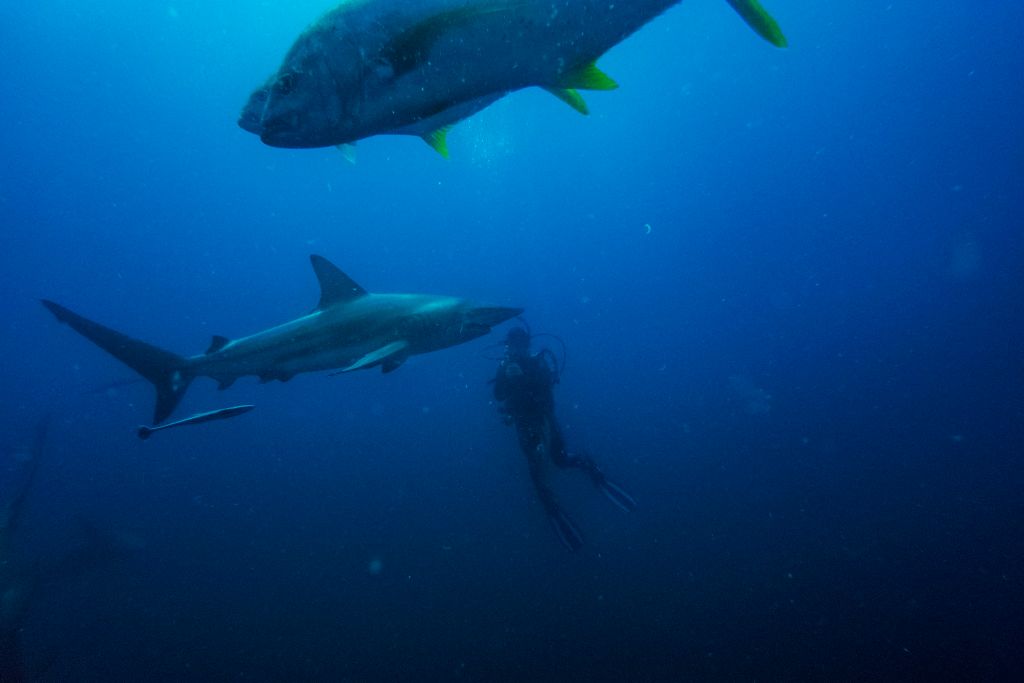Summary of About 50 Tiger Sharks Filmed on Feeding on Humpback Whale’s Remains on Hervey Bay Coast, Australia:
A video filmed off the coast of Hervey Bay in Queensland, Australia, showed 50 tiger sharks aggressively feeding on a dead Humpback whale. The video highlights the relationship between sharks and whales, as tiger sharks are known to hunt deceased, dying, or stranded humpback whales. The Queensland Environment advises people to stay away from deceased marine animals. Additionally, a separate incident was reported where a tiger shark was recorded near Mullaloo Beach in Western Australia, emphasizing the need for beachgoers to be alert and stay in designated areas with lifeguards. Tiger sharks can potentially reach up to six meters in length and are known to be aggressive and active at night.
1. A video captured 50 tiger sharks feeding on a dead humpback whale in Hervey Bay, Australia.
2. Dead whales are a food source for marine animals, including tiger sharks.
3. It is advised that people stay away from deceased marine animals.
4. Tigers sharks are known to hunt deceased, dying, or stranded humpback whales.
5. Beachgoers should be alert to shark presence and swim in supervised areas.
Regarding the delicate balance of nature and the wonders of the underwater world, few spectacles are as fascinating as the encounter between a group of tiger sharks and a dead humpback whale. Recently, a video captured a feeding frenzy on the shores of Hervey Bay in Queensland, Australia, where 50 tiger sharks were seen vigorously devouring the remains of a deceased whale. This mesmerizing interaction between these apex predators and the lifeless giant serves as a reminder of the raw power and dynamics of marine life.
The video quickly spreads across news outlets and social media platforms and offers a unique glimpse into the relationship between sharks and whales. While it may seem alarming to witness such a feeding frenzy, it is essential to remember that deceased whales serve as a valuable food source for marine animals and carnivores, including tiger sharks. These creatures have evolved to detect the scent of a dying or stranded humpback whale, making them an easy target for an opportunistic shark.
The waters off the coast of Australia are known for their abundance of marine life, including the majestic humpback whales that migrate through the region. Unfortunately, with an increasing number of migrating whales, there is also a rise in natural deaths. When a whale succumbs to sickness or natural causes, it often becomes a feast for various variousness, including sharks. It is common to find dead whale areas attracting an array of sharks, as they can travel long distances to partake in the feast.
While it may be tempting for onlookers to get closer to witness this fascinating spectacle, experts advise against it. The Queensland Environment has warned Australians and tourists to avoid deceased marine animals. Tiger sharks, in particular, are known for their aggressive nature and can become more active at night when hunting for their prey. To ensure beachgoers’ safety, swimming in supervised and designated areas with patrolling lifeguards is essential. If there are nearby sharks, it is essential to immediately exit the water and inform the authorities.
In a separate incident captured on drone footage, a tiger shark was seen approaching Mullaloo Beach in Western Australia, coming perilously close to shore. This serves as a reminder that shark presence is possible even in areas frequented by swimmers and surfers. The incident highlights the importance of remaining vigilant and aware of potential risks when enjoying the waters. By adhering to safety guidelines and staying informed about local conditions, individuals can minimize the chances of encountering a shark in their recreational activities.
In May, a surfer went missing on South Australia’s west coast, suspected of falling victim to a shark attack. The incident serves as a sobering reminder of the power and unpredictability of these apex predators. While shark attacks may be rare, they are possible, and respecting their natural habitats and behaviors is essential.
The tiger shark, known for its distinctive markings and robust build, can reach at least six meters long. This species is prevalent in South Western Australia, the New South Wale Coast, and certain parts of Southern Australia. Tiger sharks are opportunistic predators and have been known to consume a variety of prey, including seabirds, fish, and even smaller sharks. With a lifespan of up to 30 years, these creatures play an important role in maintaining the balance of marine ecosystems.
In conclusion, the video of 50 tiger sharks feeding on a dead humpback whale off the coast of Hervey Bay, Australia, offers a unique and captivating insight into the intricate relationships within the marine world. While it may be tempting to witness this phenomenon up close, it is essential to remember the potential dangers and prioritize the safety of humans and marine animals. By respecting the natural behaviors and habitats of creatures like the tiger shark, we can continue to appreciate and protect the delicate balance of our oceans.


